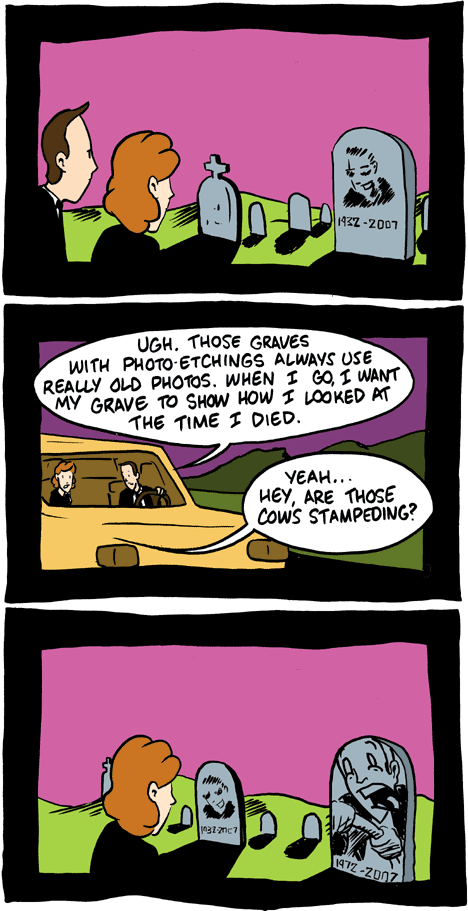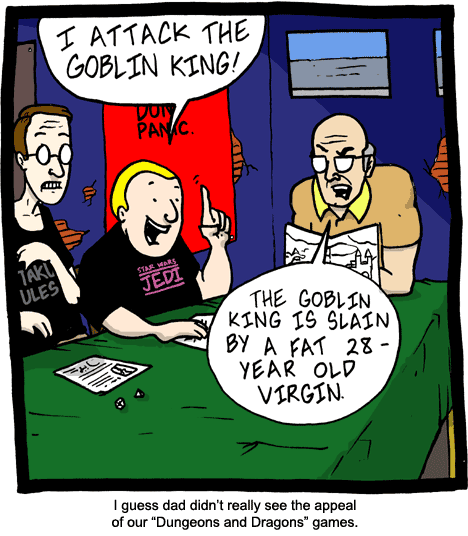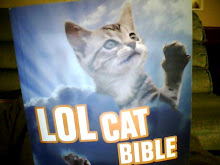Essentially, a webcomic is the next stage of evolution of the classic newspaper print comics, like Peanuts,Calvin and Hobbes, or Bloom County. Classical comic artists like Berkeley Breathed or Bill Watterson often railed against the restrictions of the panel format, and now, with the interwebs, all such restrictions are lifted.
For those of you completely out of the loop, a comic strip is a form of art where a series of pictures, accompanied by words (usually) tells a story. Often humorous, like Jim Davis' Garfield (okay, bad example, that hasn't been funny for years... uh... Gary Larson's The Far Side) they can often be more dramatic.
A problem with traditional comics is they get too comfortable. Strips like Hi and Lois, Beetle Bailey or Hager the Horrible have been around for decades. Their humor is built on safeness, family friendliness and consistency.
With webcomics, the veil of readership approval has been removed. No longer are artists censored by publications weary of offending the very young and very old. Literally thousands of webcomics have been produced in the last two decades, with some older webcomics already boasting archives of over 2,000 strips.
One strip, active since late 2002 is Saturday Morning Breakfast Cereal, written by Zach Weiner. Mr. Weiner is a professional artist, and actually makes a living off of the webcomic he produces, from products and advertising.
In an e-mail correspondence, he writes (on being a webcomic artist), "It pays the rent. Seriously, everything else about it is nice, but nothing's nicer than making a living as an artist."
Zach's style is off the wall, producing non-linear comics that each produce a joke, usually in a single panel. His subjects vary, but he frequently touches on religion:
(All SMBC comics property of Zach Weiner)

And occasionally, SMBC dabbles in darker humor:

Seeing as how most webcomic readers are usually a little bit nerdy, Zach isn't afraid to go after his own audience either:

SMBC is a well-established, successful webcomic. A community of fans has arisen around the site, consisting of around 650 members, with almost 80,000 posts. Despite the community that exits solely because of his artistic creation, Zach has managed to remain fairly humble:
"Thanks to The Magic of the Internet, despite apparently having many readers, I rarely have contact directly with anyone. So, other than that my bank account is a little larger, and I eat out a little more, my life hasn't been changed by the modicum of "fame" I've received in the last
few years," he writes.
Any community needs managing, and a webcomic forum is no exception. Unfortunately, with the busy lifestyle of a self-managed, self-publishing artist, there is often only a little amount of time to work with, so helpers are often needed.
"I used to spend more time on it, but the burgeoning business has forced me to focus on writing and organizational stuff," Zach writes about his forums. "Fortunately, I have some very good mods."
Another webcomic is the up and coming Hitmen for Destiny, written by the talented Oyvind Thorsby. His specialties are strange monsters and convoluted, impossibly complex situations that slowly but surely grow hilariously out of control for the poor, confused characters wrapped up in them.
Perhaps his finest arc yet, Passion Lies and Fungus starts relatively simple, a basic case of mistaken identity and a disguised monster steadily growing into an impossible to decipher rapidly deteriorating situation.
His other specialty is describing monsters, always specified from an evolutionary standpoint, whose odd attributes are almost always relevant to the plot later, such as the Razor Spinners and Safety Hair Rabbits.
For Mr. Thorsby, the webcomic isn't a job, it's for fun. "It's a hobby," he writes. He enjoys it "When I get a good idea for the plot. Also, I like drawing new monsters."
His comic is fairly young by webcomic standards and doesn't yet have a forum or a large following. He has already been linked to by larger webcomics by artists appreciative of his storytelling talent.
A webcomic isn't easy to produce. Weiner's strips take 1-6 hours, while Thorsby usually spends around 3-5 hours per comic he produces. Keeping in mind that Zach updates usually around 4-5 times a week and Oyvind produces very long comics 2-3 times a week, you can begin to understand the effort that goes into the production process.
"If it's just 2 characters that sit and talk, I draw almost nothing new, but if it's an action sequence I tend to draw new stuff for every panel. Maybe 15 hours for the longest ones," Thorsby writes about his creative process.
For some, the work pays off. Large t-shirt companies like topatoco sell merchandise for beginning webcomics, and money from that and advertising allow some to live off of their art.
In a way, this is the newest form of art. Rather than separation of artist and publisher, the artist is now in charge of the advertising, hosting and business aspects of his work.
Yet another permutation of society brought upon by the advent of the interwebs, webcomics have an enormous potential to build communities around them. These can act as centers of society for the growing interwebs proto-nation.
For every possible taste or interest, there is a webcomic about it. The sites at the top are great places to start, and google can help too. Finding a webcomic that suits your interests is easy, and they can be quickly checked with e-mail and facebook on a daily basis. I would encourage anyone to check up on this interesting new art form.

No comments:
Post a Comment